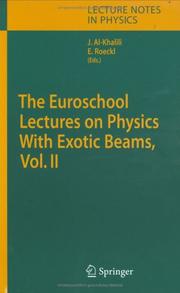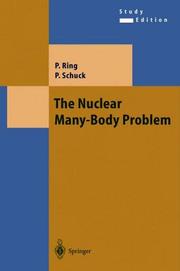| Listing 1 - 4 of 4 |
Sort by
|
Book
ISBN: 1280439777 9786610439775 1423736109 0195364414 1601296371 9781423736103 9781601296375 9781280439773 0195045998 661043977X 9780195364415 Year: 1990 Publisher: New York, New York ; Oxford, [England] : Oxford University Press,
Abstract | Keywords | Export | Availability | Bookmark
 Loading...
Loading...Choose an application
- Reference Manager
- EndNote
- RefWorks (Direct export to RefWorks)
The study of the low energy collective and single particle excitations of medium and heavy nuclei has undergone a rapid development. This book aims to survey and assess this development, from both the experimental and theoretical perspectives. It is intended for graduate students in this area.
Nuclear structure. --- Nuclear excitation. --- Collective excitations. --- Excitations, Collective --- Energy-band theory of solids --- Exciton theory --- Excitation, Nuclear --- Energy levels (Quantum mechanics) --- Nuclear physics --- Structure, Nuclear --- Collective excitations --- Nuclear excitation --- Nuclear structure --- 539.14 --- 539.14 Nuclei --- Nuclei

ISBN: 3540337865 9783540337867 9786610615469 128061546X 3540337873 Year: 2006 Publisher: Berlin ; Heidelberg ; New York : Springer,
Abstract | Keywords | Export | Availability | Bookmark
 Loading...
Loading...Choose an application
- Reference Manager
- EndNote
- RefWorks (Direct export to RefWorks)
This is the second volume in a series of Lecture Notes based on the highly successful Euro Summer School on Exotic Beams. The aim of these notes is to provide a thorough introduction to radioactive ion-beam physics at the level of graduate students and young postdocs starting out in the field. Each volume covers a range of topics from nuclear theory to experiment and applications. Vol I has been published as LNP 651, ISBN 3-540-22399-1.
Exotic nuclei -- Congresses. --- Radioactive nuclear beams -- Congresses. --- Electricity & Magnetism --- Nuclear Physics --- Physics --- Physical Sciences & Mathematics --- 539.14 --- 539.16 --- Nuclei --- Radioactivity. Radioactive decay --- 539.16 Radioactivity. Radioactive decay --- 539.14 Nuclei --- Radioactive nuclear beams --- Exotic nuclei --- Nuclei, Exotic --- Beams, Radioactive nuclear --- Nuclear beams, Radioactive --- Radioactive beams --- Physics. --- Nuclear physics. --- Heavy ions. --- Hadrons. --- Particle acceleration. --- Physical measurements. --- Measurement. --- Nuclear Physics, Heavy Ions, Hadrons. --- Particle Acceleration and Detection, Beam Physics. --- Measurement Science and Instrumentation. --- Measuring --- Mensuration --- Mathematics --- Technology --- Metrology --- Physical measurements --- Measurements, Physical --- Mathematical physics --- Measurement --- Particles (Nuclear physics) --- Acceleration (Mechanics) --- Nuclear physics --- Strongly interacting particles --- Partons --- Ions --- Atomic nuclei --- Atoms, Nuclei of --- Nucleus of the atom --- Natural philosophy --- Philosophy, Natural --- Physical sciences --- Dynamics --- Acceleration --- Particle beams --- Measurement .

ISBN: 0387098208 1441918914 9786611920043 1281920045 0387098216 9783540098201 9780387098203 3540098208 Year: 1980 Publisher: New York, N.Y. Springer
Abstract | Keywords | Export | Availability | Bookmark
 Loading...
Loading...Choose an application
- Reference Manager
- EndNote
- RefWorks (Direct export to RefWorks)
Stifling Political Competition synthesizes political science, economics, and history to demonstrate how the two-party system is the artificial creation of a network of laws, restrictions, and subsidies that favor the Democrats and Republicans and cripple potential challengers, depriving voters of truly vigorous political debate. Daring in its criticism of the current state of affairs and provocative in its calls for radical reform, Stifling Political Competition is a timely and important contribution to any discussion of the impact of party politics and the prospects for achieving effective representation. Stifling Political Competition is a carefully researched and highly readable book that shows how federal, state, and local governments have enacted laws, regulations, and subsidies that discriminate in favor of the Democratic and Republican parties and virtually prohibit challenges by independent parties and candidates. The unfortunate result is limited choice in the political arena. This book is essential reading for anyone interested in political competition and public policy. Walter E. Williams, John M. Olin Distinguished Professor of Economics, George Mason University Finally, a book that exposes the reality that U.S. elections are substantially less free and less meaningful than elections in most other developed nations. Professor Bennett, an economist, has given us a book that should have emerged long ago from the ranks of political scientists. Stifling Political Competition is an interesting and very well-written study full of insights into the election process. Richard Winger, Editor, Ballot Access News In Stifling Political Competition, James Bennett combines a detailed historical analysis of the rise of the two party system with the insights of the public choice school of economics to explain how the American people are ill-served by laws that limit their choices at the ballot box. Every American looking for ways to increase voter participation and open up the political process to all points of view should read this important book." Norman Kirk Singleton, Legislative Director, Congressman Ron Paul James T. Bennett is Eminent Scholar and William P. Snavely Professor of Political Economy and Public Policy at George Mason University and Director of The John M. Olin Institute for Employment Practice and Policy. He is the author of numerous scholarly articles and over a dozen books, including From Pathology to Politics, Unhealthy Charities, and The Politics of American Feminism.
Political corruption --United States. --- Political parties --United States. --- Third parties (United States politics). --- United States --Politics and government --1945-1989. --- United States --Politics and government --1989-. --- Political parties --- Third parties (United States politics) --- Political corruption --- Political Science - General --- Political Rights - U.S. --- Atomic Physics --- Political Science --- Government - U.S. --- Physics --- Law, Politics & Government --- Physical Sciences & Mathematics --- United States --- Politics and government --- Political science. --- History. --- Political Science and International Relations. --- Political Science. --- History, general. --- Annals --- Auxiliary sciences of history --- Administration --- Civil government --- Commonwealth, The --- Government --- Political theory --- Political thought --- Politics --- Science, Political --- Social sciences --- State, The --- Statistical physics --- Quantum mechanics. Quantumfield theory --- Nuclear physics --- Many-body problem --- Many-body problem. --- Nuclear physics. --- 530.19 --- 539.14 --- 539.14 Nuclei --- Nuclei --- 530.19 Fundamental functions in general. Potential. Gradient. Intensity. Capacity etc. --- Fundamental functions in general. Potential. Gradient. Intensity. Capacity etc.
Book
ISBN: 9783642008290 9783642008283 3642008283 9786613559753 3642008291 1280381841 Year: 2010 Publisher: Berlin, Heidelberg Springer Berlin Heidelberg
Abstract | Keywords | Export | Availability | Bookmark
 Loading...
Loading...Choose an application
- Reference Manager
- EndNote
- RefWorks (Direct export to RefWorks)
The book is based on a course in nuclear and particle physics that the author has taught over many years to physics students, students in nuclear engineering and students in biomedical engineering. It provides the basic understanding that any student or researcher using such instruments and techniques should have about the subject. After an introduction to the structure of matter at the subatomic scale, it covers the experimental aspects of nuclear and particle physics. Ideally complementing a theoretically-oriented textbook on nuclear physics and/or particle physics, it introduces the reader to the different techniques used in nuclear and particle physics to accelerate particles and to measurement techniques (detectors) in nuclear and particle physics. The main subjects treated are: interactions of subatomic particles in matter; particle accelerators; basics of different types of detectors; and nuclear electronics. The book will be of interest to undergraduates, graduates and researchers in both particle and nuclear physics. For the physicists it is a good introduction to all experimental aspects of nuclear and particle physics. Nuclear engineers will appreciate the nuclear measurement techniques, while biomedical engineers can learn about measuring ionising radiation, the use of accelerators for radiotherapy. What’s more, worked examples, end-of-chapter exercises, and appendices with key constants, properties and relationships supplement the textual material.
Nuclear physics --- Physique nucléaire --- Experiments --- Expériences --- Particles (Nuclear physics) --- Nuclear counters --- Radiation --- Technique --- Measurement --- Biomedical engineering. --- Experiments. --- Nuclear engineering. --- Nuclear physics. --- Nuclear physics -- Experiments. --- Particle acceleration. --- Physics. --- Physics --- Nuclear Physics --- Physical Sciences & Mathematics --- 539.14 --- Nuclei --- Nuclear counters. --- Detektor. --- Elementarteilchenphysik. --- Kernphysik. --- Messtechnik. --- Technique. --- Measurement. --- 539.14 Nuclei --- Physique nucléaire --- Expériences --- EPUB-LIV-FT LIVPHYSI SPRINGER-B --- Atomic nuclei --- Atoms, Nuclei of --- Nucleus of the atom --- Heavy ions. --- Hadrons. --- Physical measurements. --- Nuclear Physics, Heavy Ions, Hadrons. --- Particle Acceleration and Detection, Beam Physics. --- Nuclear Engineering. --- Biomedical Engineering. --- Particle and Nuclear Physics. --- Measurement Science and Instrumentation. --- Nuclear Energy. --- Biomedical Engineering and Bioengineering. --- Clinical engineering --- Medical engineering --- Bioengineering --- Biophysics --- Engineering --- Medicine --- Acceleration (Mechanics) --- Acceleration --- Monograph --- Nuclear energy. --- Measurement . --- Measuring --- Mensuration --- Mathematics --- Technology --- Metrology --- Physical measurements --- Measurements, Physical --- Mathematical physics --- Atomic energy --- Atomic power --- Energy, Atomic --- Energy, Nuclear --- Nuclear power --- Power, Atomic --- Power, Nuclear --- Force and energy --- Power resources --- Nuclear engineering --- Nuclear facilities --- Nuclear power plants --- Ions --- Nuclear physics - Technique --- Particles (Nuclear physics) - Technique --- Radiation - Measurement --- Nuclear physics - Experiments --- Particles (Nuclear physics) - Experiments --- Neutron --- Particle Physics --- Particle accelerator --- detector gas ionization --- electronics nuclear detector --- meassurement technique nuclear --- particle acceleration --- principle particle accelerator --- radiation matter --- subatomic poarticles --- textbook detector --- textbook nuclear experiments --- textbook nuclear physics --- textbook particle acceleration --- textbook particle physics
| Listing 1 - 4 of 4 |
Sort by
|

 Search
Search Feedback
Feedback About UniCat
About UniCat  Help
Help News
News